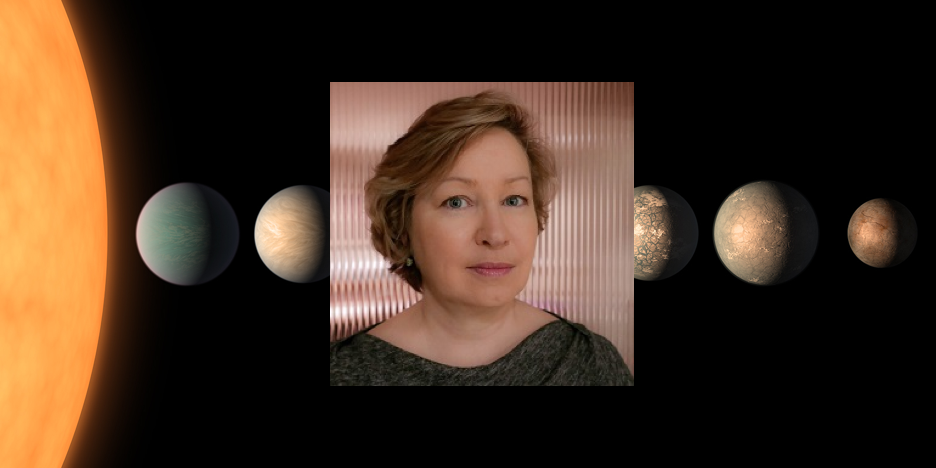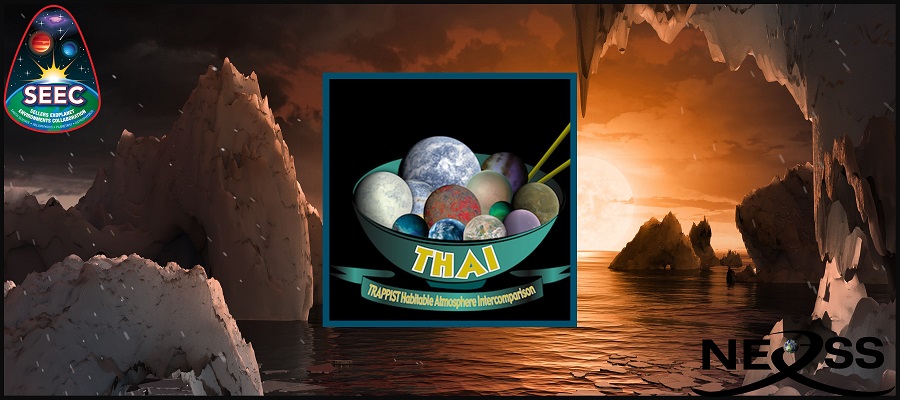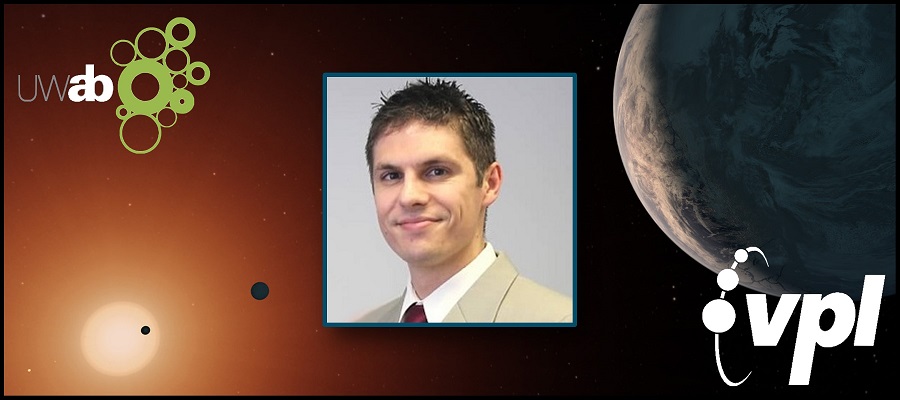The work of VPL PI Prof. Victoria Meadows was recently featured in AAS Nova. Her work, along with VPL researchers…
VPL Postdoctoral Researcher, Andrew Lincowski (University of Washington), and VPL project PI, Victoria Meadows (University of Washington), published two new…
The observation of a 266.94 GHz feature in the Venus spectrum has been attributed to phosphine (PH3) in the Venus clouds, suggesting unexpected geological, chemical, or even biological processes. Since both PH3 and sulfur dioxide (SO2) are spectrally active near 266.94 GHz, the contribution to this line from SO2 must be determined before it can be attributed, in whole or part, to PH3. An undetected SO2 reference line, interpreted as an unexpectedly low SO2 abundance, suggested that the 266.94 GHz feature could be attributed primarily to PH3. However, the low SO2 and the inference that PH3 was in the cloud deck posed an apparent contradiction. Here we use a radiative transfer model to analyze the PH3 discovery, and explore the detectability of different vertical distributions of PH3 and SO2. We find that the 266.94 GHz line does not originate in the clouds, but above 80 km in the Venus mesosphere. This level of line formation is inconsistent with chemical modeling that assumes generation of PH3 in the Venus clouds. Given the extremely short chemical lifetime of PH3 in the Venus mesosphere, an implausibly high source flux would be needed to maintain the observed value of 20 ± 10 ppb. We find that typical Venus SO2 vertical distributions and abundances fit the JCMT 266.94 GHz feature, and the resulting SO2 reference line at 267.54 GHz would have remained undetectable in the ALMA data due to line dilution. We conclude that nominal mesospheric SO2 is a more plausible explanation for the JCMT and ALMA data than PH3.
Recently published Atacama Large Millimeter Array (ALMA) observations suggest the presence of 20 ppb PH3 in the upper clouds of Venus. This is an unexpected result, as PH3 does not have a readily apparent source and should be rapidly photochemically destroyed according to our current understanding of Venus atmospheric chemistry. While the reported PH3 spectral line at 266.94 GHz is nearly colocated with an SO2 spectral line, the nondetection of stronger SO2 lines in the wideband ALMA data is used to rule out SO2 as the origin of the feature. We present a reassessment of wideband and narrowband data sets derived from these ALMA observations. The ALMA observations are re-reduced following both the initial and revised calibration procedures discussed by the authors of the original study. We also investigate the phenomenon of apparent spectral line dilution over varying spatial scales resulting from the ALMA antenna configuration. A 266.94 GHz spectral feature is apparent in the narrowband data using the initial calibration procedures, but this same feature cannot be identified following calibration revisions. The feature is also not reproduced in the wideband data. While the SO2 spectral line is not observed at 257.54 GHz in the ALMA wideband data, our dilution simulations suggest that SO2 abundances greater than the previously suggested 10 ppb limit would also not be detected by ALMA. Additional millimeter, submillimeter, and infrared observations of Venus should be undertaken to further investigate the possibility of PH3 in the Venus atmosphere.
The NASA Nexus for Exoplanet Systems Science (NExSS) and Sellers Exoplanet Environments Collaboration recently hosted the TRAPPIST Habitable Atmospheres Intercomparison…
VPL graduate student at the University of Washington, Andrew Lincowski, successfully defended his dissertation on Thursday February 27th! Andrew was…
Near-term studies of Venus-like atmospheres with James Webb Space Telescope (JWST) promise to advance our knowledge of terrestrial planet evolution. However, the remote study of Venus in the solar system and the ongoing efforts to characterize gaseous exoplanets both suggest that high altitude aerosols can limit observational studies of lower atmospheres, and potentially make it challenging to recognize exoplanets as “Venus-like.” To support practical approaches for exo-Venus characterization with JWST, we use Venus-like atmospheric models with self-consistent cloud formation of the seven TRAPPIST-1 exoplanets to investigate the atmospheric depth that can be probed using both transmission and emission spectroscopy. We find that JWST/Mid-IR Instrument Low Resolution Spectrometer secondary eclipse emission spectroscopy in the 6 ?m opacity window could probe at least an order of magnitude deeper pressures than transmission spectroscopy, potentially allowing access to the subcloud atmosphere for the two hot innermost TRAPPIST-1 planets. In addition, we identify two confounding effects of sulfuric acid aerosols that may carry strong implications for the characterization of terrestrial exoplanets with transmission spectroscopy: (1) there exists an ambiguity between cloud-top and solid surface in producing the observed spectral continuum; and (2) the cloud-forming region drops in altitude with semimajor axis, causing an increase in the observable cloud-top pressure with decreasing stellar insolation. Taken together, these effects could produce a trend of thicker atmospheres observed at lower stellar insolationa convincing false positive for atmospheric escape and an empirical “cosmic shoreline.” However, developing observational and theoretical techniques to identify Venus-like exoplanets and discriminate them from stellar windswept worlds will enable advances in the emerging field of terrestrial comparative planetology.
Terrestrial planets orbiting M dwarfs may soon be observed with the James Webb Space Telescope (JWST) to characterize their atmospheric composition and search for signs of habitability or life. These planets may undergo significant atmospheric and ocean loss due to the superluminous pre-main-sequence phase of their host stars, which may leave behind abiotically generated oxygen, a false positive for the detection of life. Determining if ocean loss has occurred will help assess potential habitability and whether or not any O2 detected is biogenic. In the solar system, differences in isotopic abundances have been used to infer the history of ocean loss and atmospheric escape (e.g., Venus, Mars). We find that isotopologue measurements using transit transmission spectra of terrestrial planets around late-type M dwarfs like TRAPPIST-1 may be possible with JWST, if the escape mechanisms and resulting isotopic fractionation were similar to Venus. We present analyses of post-ocean-loss O2- and CO2-dominated atmospheres containing a range of trace gas abundances. Isotopologue bands are likely detectable throughout the near-infrared (18 ?m), especially 34 ?m, although not in CO2-dominated atmospheres. For Venus-like D/H ratios 100 times that of Earth, TRAPPIST-1b transit signals of up to 79 ppm are possible by observing HDO. Similarly, 18O/16O ratios 100 times that of Earth produce signals at up to 94 ppm. Detection at signal-to-noise ratio = 5 may be attained on these bands with as few as four to 11 transits, with optimal use of JWST’s NIRSpec Prism. Consequently, H2O and CO2 isotopologues could be considered as indicators of past ocean loss and atmospheric escape for JWST observations of terrestrial planets around M dwarfs.
The James Webb Space Telescope (JWST) will offer the first opportunity to characterize terrestrial exoplanets with sufficient precision to identify high mean molecular weight atmospheres, and TRAPPIST-1’s seven known transiting Earth-sized planets are particularly favorable targets. To assist community preparations for JWST observations, we use simulations of plausible post-ocean-loss and habitable environments for the TRAPPIST-1 exoplanets, and test simulations of all bright object time-series spectroscopy modes and all Mid-Infrared Instrument photometry filters to determine optimal observing strategies for atmospheric detection and characterization using both transmission and emission observations. We find that transmission spectroscopy with the Near-Infrared Spectrograph Prism is optimal for detecting terrestrial, CO2-containing atmospheres, potentially in fewer than 10 transits for all seven TRAPPIST-1 planets, if they lack high-altitude aerosols. If the TRAPPIST-1 planets possess Venus-like H2SO4 aerosols, up to 12 times more transits may be required to detect an atmosphere. We present optimal instruments and observing modes for the detection of individual molecular species in a given terrestrial atmosphere and an observational strategy for discriminating between evolutionary states. We find that water may be prohibitively difficult to detect in both Venus-like and habitable atmospheres, due to its presence lower in the atmosphere where transmission spectra are less sensitive. Although the presence of biogenic O2 and O3 will be extremely challenging to detect, abiotically produced oxygen from past ocean loss may be detectable for all seven TRAPPIST-1 planets via O2O2 collisionally induced absorption at 1.06 and 1.27 ?m, or via NIR O3 features for the outer three planets. Our results constitute a suite of hypotheses on the nature and detectability of highly evolved terrestrial exoplanet atmospheres that may be tested with JWST.
The TRAPPIST-1 planetary system provides an unprecedented opportunity to study terrestrial exoplanet evolution with the James Webb Space Telescope (JWST) and ground-based observatories. Since M dwarf planets likely experience extreme volatile loss, the TRAPPIST-1 planets may have highly evolved, possibly uninhabitable atmospheres. We used a versatile, 1D terrestrial planet climate model with line-by-line radiative transfer and mixing length convection (VPL Climate) coupled to a terrestrial photochemistry model to simulate environmental states for the TRAPPIST-1 planets. We present equilibrium climates with self-consistent atmospheric compositions and observational discriminants of postrunaway, desiccated, 10–100 bar O2- and CO2-dominated atmospheres, including interior outgassing, as well as for water-rich compositions
(The Astrophysical Journal, 2018)
“A group of leading researchers in astronomy, biology and geology have come together under NASA’s Nexus for Exoplanet System Science, or…
Proxima Centauri b provides an unprecedented opportunity to understand the evolution and nature of terrestrial planets orbiting M dwarfs. Although Proxima Cen b orbits within its star’s habitable zone, multiple plausible evolutionary paths could have generated different environments that may or may not be habitable. Here, we use 1-D coupled climate-photochemical models to generate self-consistent atmospheres for several evolutionary scenarios, including high-O2, high-CO2, and more Earth-like atmospheres, with both oxic and anoxic compositions. We show that these modeled environments can be habitable or uninhabitable at Proxima Cen b’s position in the habitable zone. We use radiative transfer models to generate synthetic spectra and thermal phase curves for these simulated environments, and use instrument models to explore our ability to discriminate between possible planetary states.



